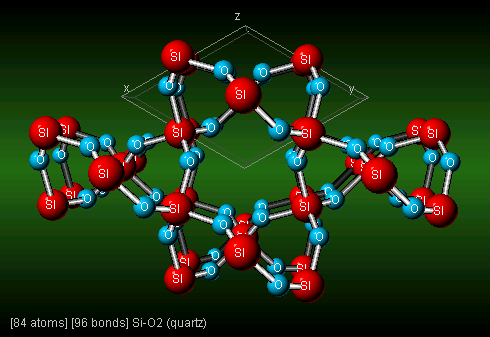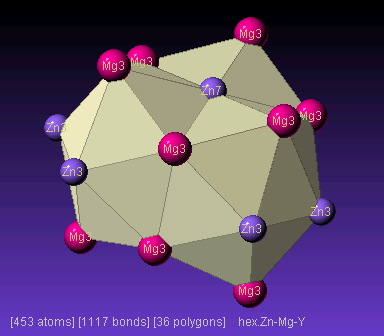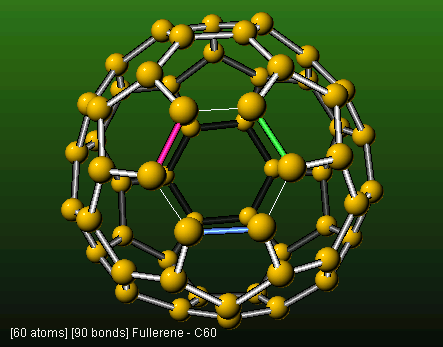- runs on Windows, Solaris, Linux
- accepts input data for asymmetric
unit cell, full unit cell or cartesian coordinates
- all spacegroup symmetries
included for
generating atom positions
- atom display modes: shaded spheres, discs,
circles
- stereo pairs
- coordination polyhedra
- real time rotations by mouse drags (use
economy mode if necessary)
- shifting and zooming by mouse drag
- measuring distances and
angles by clicking atoms
- removing atoms by mouse clicks
- optional sliders for atom radius factor, bond
radius, zoom and perspective factor
- inputfile editor
- periodic table for
radius and atom color settings
- output of PostSript, VRML1.0,
VRML2.0, GIF, JPG
- simple bond creation (by clicking
at atoms)
- show spherical regions
around a selected atom (study site environment)
- select any atom as rotation
center
- 3D/2D X-ray diffraction patterns (real time rotation and
layer scanning) + Laue pattern
- Stereographic
projections onto Wulff-net
- unit cell
visualizer (based
on my JCELL applet)
- periodic table
with basic elemt properties (based on my JPT applet)
- direct printing
support under Windows/Solaris (raster image, spooling
is quite slow)
- new in
JSV1.07
- external Java3D window (you need to install the Java3D
API)
- search and display of interstitial spaces
(search options include
radius,neighbours,coordination)
- calculate the radius of a hole at a given
position
- import of several structure file formats:
MICRO-POWD (*.pwd), POWDERCELL (*.cel),
FAT-RIETAN (*.cif)
- an additional JPG output routine (using JDK's own JPG encoder)
- stick bar diagram in the XRDL modul (2theta positions)
- file history list, and save size and
location of JSV on screen
- interstital viewer modul
- powder diffractogram viewer modul (MICRO-POWD's
*.cmb files and MDI's *.mdi files)
- difference plot viewer modul (FAT-RIETAN's
IGOR files)
- individual bond styles and colors
- new in
JSV1.08lite
- fixed bugs (cell range, color PostScript,
history)
- new polygon menu for adding polyhedra
manually
- new shading for spheres (onscreen and
PostScript)
- new in
JSV1.08
- new: imports SHELX,
ICSD, PDB, MOL
- new: POVRAY
file output
- new: generates chiral
nano-tubes (C, BN) !!!
- new: generates nano-cones
(C,BN) !!!
- new: provides and
imports Fullerene library
!!!
filename extensions
JSV input files DO NOT NEED to
have a file extension (eg. *.jsv) .
However I recommend to use them, since that allows you to
associate these files with jsv.bat (under
Windows) for automatically starting JSV when you double
click a *.jsv file. The *.SDF files (Structure
Description File) which are created by JSV NEED
the extension *.SDF !
polyhedra
At present JSV only supports
tetrahedra and octahedra. (squares, cubes, triangles may
be created for VRML output, but they will be incorrectly
displayed within JSV)
- click here to see how to make tetrahedra
- click here to see how to make octahedra
You may also add polyhedra
manually (not generated) using the new menu:
Polygons . Then polyhedra such as cubes or
square pyramids can be used also. I used this technique
to create the High-Tc superconductor gallery.
update information
request
Please let me know if anyone of
you has tested JSV successfully on SOLARIS or a LINUX
distribution other than RedHat5.2.
|
 1.08lite
1.08lite

